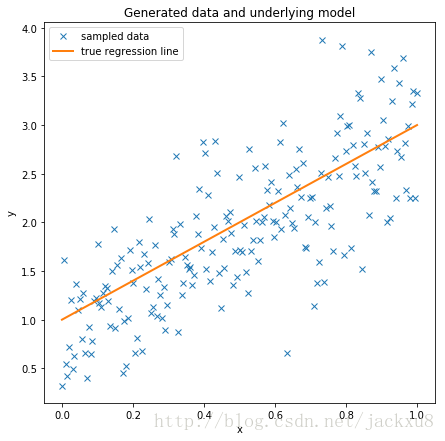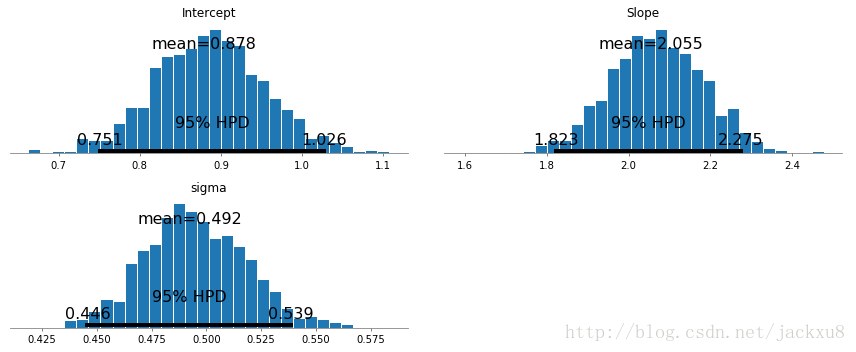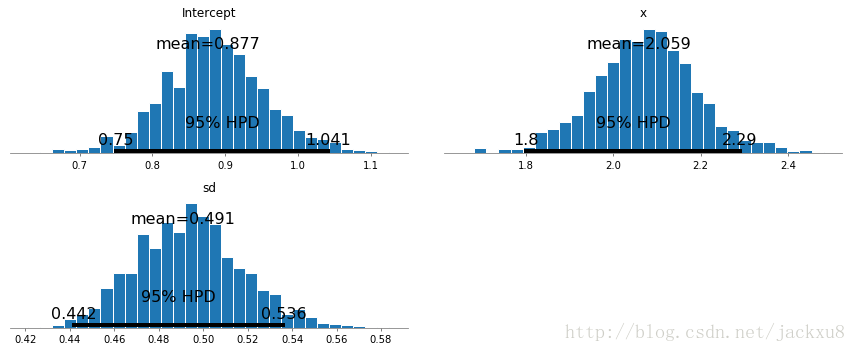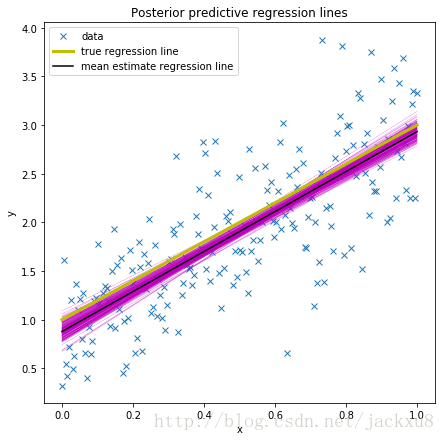GLM:线性回归
GLM即Generalized linear model,广义线性模型。
贝叶斯统计的一些软件工具包JAGS, BUGS, Stan 和 PyMC,使用这些工具包需要对将要简历的模型有充分的了解。
线性回归的传统形式
通常,频率学派将线性回归表述为:
其中, Y 是我们期望预测的输出(因变量);
可以使用普通最小二乘或者最大似然法找到 β 的最优解。
线性回归的概率形式
贝叶斯学派采样概率分布形式描述线性回归模型,可表达为如下形式:
其中, Y 是一个随机变量,其取值(每个数据点)服从正态分布。这个正态分布的均值有线性变量
这个描述有如下两个优点:
* 先验:可以将我们已有的任何先验赋予参数。
* 量化不确定性:不仅得到单个
β
的估计,而是得到
β
的整个后验,表征了
β
对不同取值的可能性。
PyMC3中的贝叶斯GLMs
使用PyMC3中的GLM模型可以简单的构建复杂模型。
%matplotlib inline
import pymc3 as pm
import numpy as np
import matplotlib.pyplot as plt生成数据
以截距和斜率产生一条直线,并以直线位均值在其附近产生正态分布的数据点。
# data size
size = 200
# true line parameter
true_intercept = 1
true_slope = 2
# y = a + b*x
x = np.linspace(0, 1, size)
true_regression_line = true_intercept + true_slope * x
# add noise (sampled data)
y = true_regression_line + np.random.normal(scale=.5, size=size)
# simulate data
data = dict(x=x, y=y)
# plot the data
fig = plt.figure(figsize=(7, 7));
ax = fig.add_subplot(111, xlabel='x', ylabel='y', title='Generated data and underlying model');
ax.plot(x, y, 'x', label='sampled data');
ax.plot(x, true_regression_line, label='true regression line', lw=2.0);
plt.legend(loc=0);直接建模估计
使用贝叶斯线性回归进行建模并拟合这些采样数据。
with pm.Model() as naive_model: # model specifications in PyMC3 are wrapped in a with-statement
# Define priors
intercept = pm.Normal('Intercept', 0, sd=20)
slope = pm.Normal('Slope', 0, sd=20)
sigma = pm.HalfCauchy('sigma', beta=10, testval=1.)
# Define likelihood
likelihood = pm.Normal('y', mu=intercept + slope * x, sd=sigma, observed=y)使用默认采样器进行采样,PyMC3不需要特别指定采样初始值。NUTS采样器会使用ADVI进行初始化。
with naive_model:
naive_trace = pm.sample(2000)Auto-assigning NUTS sampler...
Initializing NUTS using advi...
Average ELBO = -157.32: 100%|██████████| 200000/200000 [00:18<00:00, 10888.26it/s]
Finished [100%]: Average ELBO = -157.3
100%|██████████| 2000/2000 [00:04<00:00, 432.16it/s]
绘制拟合的结果可以看出,截距(Intercept)的估计值约1.027(真实1);斜率的估计值约1.893(真实2)。噪声的方差估计值0.528(真实0.5)。进行了准确的估计。
#pm.traceplot(naive_trace);
pm.plot_posterior(naive_trace);GLM建模估计
使用GLM模块进行建模估计。
with pm.Model() as glm_model:
pm.glm.glm('y~x',data,\
{'Intercept': pm.Normal.dist(mu=0, sd=20),\
'sd':pm.HalfCauchy.dist(beta=10, testval=1.),\
'x':pm.Normal.dist(mu=0, sd=20)})??pm.glm.glmwith glm_model:
glm_trace = pm.sample(2000)Auto-assigning NUTS sampler...
Initializing NUTS using advi...
Average ELBO = -157.31: 100%|██████████| 200000/200000 [00:21<00:00, 9193.40it/s]
Finished [100%]: Average ELBO = -157.32
100%|██████████| 2000/2000 [00:05<00:00, 391.03it/s]
#pm.traceplot(glm_trace);
pm.plot_posterior(glm_trace);分析模型
贝叶斯推断不仅给出了最优的拟合直线,而且给出了待估计参数的完整后验信息。
左侧给出了三个随机变量的边缘后验:x轴表示可能的值,y轴表示取值对应的可能性。右侧给出了三个随机变量的采样值,可以看出三个随机变量都良好的收敛并稳定(没有出现跳变和奇怪的模式)。
其次,随机变量的最大后验估计很接近与真实值(参数模拟数据是给出的值)。
采用均值后验对参数进行估计。
est_intercept=naive_trace['Intercept'].mean();
est_slope=naive_trace['Slope'].mean();
est_regression_line = est_intercept + est_slope * x;??pm.glm.plot_posterior_predictiveplt.figure(figsize=(7, 7))
plt.plot(x, y, 'x', label='data');
pm.glm.plot_posterior_predictive(glm_trace,samples=200,c='m');
plt.plot(x, true_regression_line, label='true regression line', lw=3.0, c='y');
plt.plot(x,est_regression_line,label = 'mean estimate regression line',c='k');
plt.title('Posterior predictive regression lines');
plt.legend(loc=0);
plt.xlabel('x');
plt.ylabel('y');


